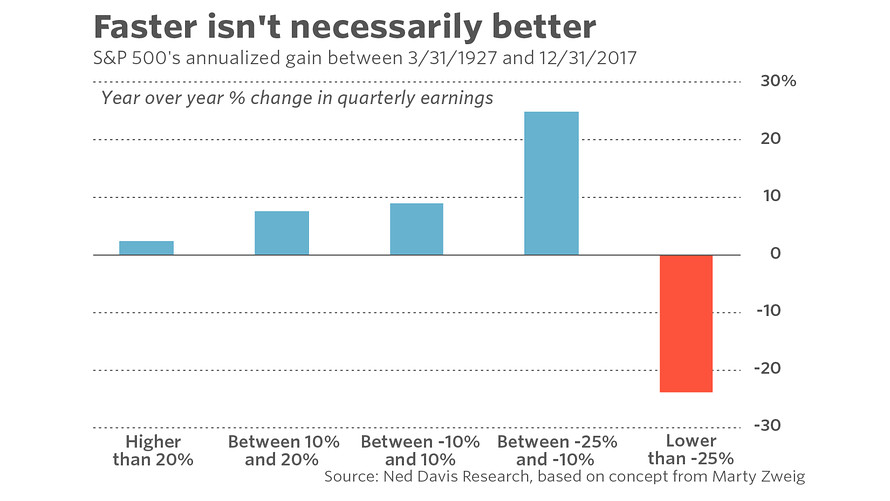猛牛
以曆史為借鑒, 以現實為根據, 以獨立判斷為基礎, 以長期投資為目標, 以基本麵分析為手段, 來謀求理想的長期盈利。
Shares do better when year-over-year profits decline
Many investors find it surprising that, in the wake of the fastest growth rate in corporate profits in many years, the U.S. stock market is struggling. In fact, however, they should have expected it. Over the past nine decades, the stock market on average has hardly produced any gain in calendar quarters in which year-over-year earnings growth is as strong as it is currently.
That seems counterintuitive in the extreme. GAAP earnings per share for the S&P 500 are projected to be 36.7% higher than the comparable quarter of a year ago, according to Standard & Poor’s. That compares to an average of just 5.9% average annual growth since the late 1980s.
What’s not to like in that? As Mae West quipped, too much of a good thing is wonderful. But, as Humphrey Neill, the father of contrarian analysis, famously said: “When everyone thinks alike, everyone is likely to be wrong.”
Consider what the data — as opposed to intuition — tell us. Since 1927, according to Ned Davis Research, the stock market has performed the best in quarters in which the S&P 500’s earnings per share are between 10% and 25% lower than where they stood one year prior. In such quarters, the S&P 500’s average annualized return is 25.0%.
That compares to an average gain of just 2.6% during those quarters — like the current one — in which year-over-year earnings growth was above 20%.
To be sure, as you can see in the chart, below, the S&P 500’s worst average quarterly performance came when year-over-year earnings growth rates were even worse than minus 25%. Such quarters were rare, however, and if we bracket them there is a perfectly inverse correlation between earnings growth rates and the S&P 500’s performance.

Why would there be an inverse correlation in most cases? The late Martin Zweig, who Davis credits with discovering this historical pattern, offered two explanations: First, the stock market discounts the future and foresees that a torrid pace of earnings growth cannot be sustained. Secondly, faster earnings growth puts more pressure on the Federal Reserve to raise interest rates and tighten monetary policy.
There’s yet another reason to be cautious now about the pace of earnings growth: Much of it reflects the one-time boost companies have received from lower tax rates. Only in the highly unlikely event that tax rates will be cut again next year by as much as they were recently will their earnings-growth rate be able to avoid reverting to their previous growth rate.
I note in this regard that Standard & Poor’s is estimating that the S&P 500’s earnings per share in the second quarter of 2019 will be “only” 7.9% higher than in the current quarter. That’s nothing to sneeze at, but represents a rapid deceleration from the growth rate in the current quarter.
The broader lesson here is that investors and their financial advisers should always subject their intuitions to empirical scrutiny. Without taking the trouble to check history, we can fool ourselves into holding a certain belief just because it seems so obviously true. In fact, it’s when something does seem obviously true, we need to go out of our way to test it empirically.
https://www.marketwatch.com/story/heres-why-stock-investors-should-hope-that-corporate-earnings-growth-shrinks-2018-05-26




